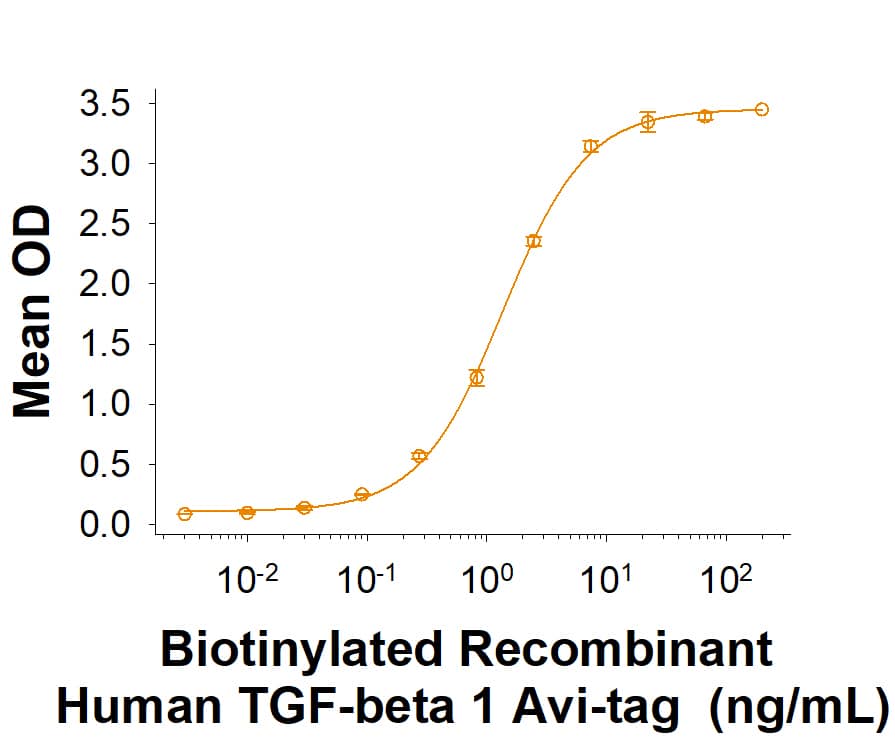Recombinant Human TGF-beta 1 Avi-tag Protein, CF
R&D Systems, part of Bio-Techne | Catalog # AVI7754
Biotinylated

Key Product Details
Learn more about Avi-tag Biotinylated Proteins
Source
HEK293
Accession #
Structure / Form
Disulfide-linked homodimer, biotinylated via Avi-tag
Conjugate
Biotin
Applications
Bioactivity
Product Specifications
Source
Human embryonic kidney cell, HEK293-derived human TGF-beta 1 protein
| Avi-tag | Human TGF-beta 1 (Ala279-Ser390) Accession # NP_000651.3 |
| N-terminus | C-terminus |
Purity
>90%, by SDS-PAGE visualized with Silver Staining and quantitative densitometry by Coomassie® Blue Staining.
Endotoxin Level
<0.10 EU per 1 μg of the protein by the LAL method.
N-terminal Sequence Analysis
Gly of Avi-tag
Predicted Molecular Mass
15 kDa
SDS-PAGE
12-16 kDa, under reducing conditions
Activity
The biotin to protein ratio is greater than 0.7 as determined by the HABA assay.
Measured by its binding ability in a functional ELISA.
When Recombinant Human TGF-beta RII Fc Chimera (Catalog # 341-BR) is immobilized at 0.1 µg/mL (100 µL/well), Biotinylated Recombinant Human TGF-beta 1 Avi-tag (Catalog # AVI7754) binds with an ED50 of 0.80-6.40 ng/mL.
Measured by its binding ability in a functional ELISA.
When Recombinant Human TGF-beta RII Fc Chimera (Catalog # 341-BR) is immobilized at 0.1 µg/mL (100 µL/well), Biotinylated Recombinant Human TGF-beta 1 Avi-tag (Catalog # AVI7754) binds with an ED50 of 0.80-6.40 ng/mL.
Scientific Data Images for Recombinant Human TGF-beta 1 Avi-tag Protein, CF
Biotinylated Recombinant Human TGF-beta 1 Avi-tag Protein Binding Activity
When Recombinant Human TGF-beta RII Fc Chimera (341-BR) is immobilized at 0.1 µg/mL (100 µL/well), Biotinylated Recombinant Human TGF-beta 1 Avi-tag (Catalog # AVI7754) binds with an ED50 of 0.80-6.40 ng/mL.Formulation, Preparation and Storage
AVI7754
| Formulation | Lyophilized from a 0.2 μm filtered solution in HCl with Trehalose. |
| Reconstitution | Reconstitute at 250 μg/mL in sterile 4 mM HCl. |
| Shipping | The product is shipped at ambient temperature. Upon receipt, store it immediately at the temperature recommended below. |
| Stability & Storage | Use a manual defrost freezer and avoid repeated freeze-thaw cycles.
|
Background: TGF-beta 1
References
- Derynck, R. and K. Miyazono (2008) Cold Spring Harbor Laboratory Press, 29.
- Dunker, N. and K. Krieglstein (2000) Eur. J. Biochem. 267:6982.
- Wahl, S.M. (2006) Immunol. Rev. 213:213.
- Chang, H. et al. (2002) Endocr. Rev. 23:787.
- Lin, J.S. et al. (2006) Reproduction 132:179.
- Hinck, A.P. et al. (1996) Biochemistry 35:8517.
- Mittl, P.R.E. et al. (1996) Protein Sci. 5:1261.
- Derynck, R. et al. (1985) Nature 316:701.
- Miyazono, K. et al. (1988) J. Biol. Chem. 263:6407.
- Oklu, R. and R. Hesketh (2000) Biochem. J. 352:601.
- de Caestecker, M. et al. (2004) Cytokine Growth Factor Rev. 15:1.
- Zuniga, J.E. et al. (2005) J. Mol. Biol. 354:1052.
Long Name
Transforming Growth Factor beta 1
Alternate Names
TGF beta1, TGFB, TGFB1, TGFbeta 1
Gene Symbol
TGFB1
UniProt
Additional TGF-beta 1 Products
Product Documents for Recombinant Human TGF-beta 1 Avi-tag Protein, CF
Product Specific Notices for Recombinant Human TGF-beta 1 Avi-tag Protein, CF
For research use only
